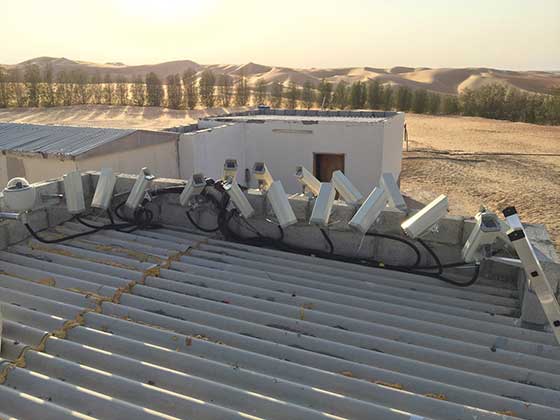The SETI Institute's CAMS meteor surveillance network begins operations in the Middle East.

It has just become harder for surprise meteor showers to escape our attention.
On October 1, the third station of a new 48-camera, video-surveillance network in the United Arab Emirates has come online to help map meteor showers. The network complements the existing 80-camera Cameras for Allsky Meteor Surveillance (CAMS) network twelve time zones later in California.
“Some meteor showers last only for hours," says SETI Institute meteor astronomer Peter Jenniskens. “Now, we can catch those even when California is on the wrong side of Earth.”
The new network was established by astronomer Mohammad Odeh of the International Astronomical Center in Abu Dhabi, with support from the United Arab Emirates Space Agency. Data are transmitted to the SETI Institute, where Jenniskens calculates the meteor trajectories as part of an ongoing NASA-sponsored meteor shower survey.
“The new network is performing well,” says Odeh. “It captured 67 meteors in the first night of observations.”
The network consists of sky-pointed, low-light video surveillance cameras located at three locations in the United Arab Emirates south of Abu Dhabi. The cameras automatically record a video file once a meteor is detected. That meteor might just be part of a meteor shower, or it could be a meteorite fall or the reentry of satellite debris. When that meteor is captured from more than one site, its trajectory is triangulated so that the meteor shower of origin can be determined, as well as the location of possible meteorite impact sites in case a meteorite fall happens over the UAE.
Each station has 17 cameras, 16 of which are running as one fly’s eye camera similar to the California CAMS network, that cover the sky above 30 degrees altitude. The 17th camera has a wide-angle lens to cover deeper penetrating parts of bright meteors and satellite reentries nearer to the horizon.

UACN2
Right on cue, as if anticipating the joy of having all camera stations in operation, the network captured a bright fireball at 16:15:58 UT on the evening of September 30. Preliminary results calculated by Jenniskens shows the meteoroid arrived with an apparent entry speed of 23 km/s from the direction Right Ascension 345 degrees and Declination +31 degrees. The object arrived on an asteroidal orbit. Small meteorites may have fallen near the city of Abu Dhabi, just west of the airport.
“The fireball was reported by several United Arab Emirates and Oman visual observers,” says Odeh, “One of those reporting the fireball from Abu Dhabi was our chairman for the International Astronomical Center.”
More information:
CAMS network: http://cams.seti.org
UAE Astronomical Camera Network: http://www.astronomycenter.net/uacn?l=en





